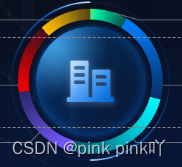vue3 echarts实现渐变色环形图
实现的效果大致是这样
由于是公司的项目,指引线后标注的内容不展示了,大致是指引线上方是name,下边是value+单位

1.定义图表容器
<div class="chart" ref="chartref" style="width: 610px; height: 260px;"></div>
2.我这边所需要的数据形式大概是
const data = {
equmentstatusechart: [
{name: '标题1', value: 10}
{name: '标题2', value: 10}
]
}通过接口拿到的数据类型一般是:[{} ,{}]这种类型的,写一个方法将其转变为我所需要的形式
const convertarraytoobject = (array) => {
const convertedobject = {
equmentstatusechart: array.map(item => ({
name: item.name,
value: item.value
}))
};
return convertedobject;
};具体的代码如下:
将接口转换成自己的就好了,我这个是随机生成的颜色渐变,如果有需求可以固定一个颜色数组
import * as echarts from 'echarts';
import { ref, onmounted, nexttick } from 'vue';
import { getpersonnel } from '@/api'
const chartref = ref(null)
//重点人员
const rangarr = ref([]);
const distribution = ref([])
const distributionlist = ref([])
const deflag = ref(1)
const anglearr = ref({})
const data = ref([])
//转换成所需对象数组
const convertarraytoobject = (array) => {
const convertedobject = {
equmentstatusechart: array.map(item => ({
name: item.communityname,
value: item.countsum,
communityid: item.communityid
}))
};
return convertedobject;
};
function getcoordinates(startarc, endarc) {
const posi = [
math.sin(startarc),
-math.cos(startarc),
math.sin(endarc),
-math.cos(endarc)
];
const dx = posi[2] - posi[0];
const dy = posi[3] - posi[1];
return getlocation(dx, dy);
}
function getlocation(dx, dy) {
const tanv = dx / dy;
const directsign = math.abs(tanv) < 1;
const t = directsign ? tanv : 1 / tanv;
const sign1 = t > 0 ? 1 : -1;
const sign2 = dx > 0 ? 1 : -1;
const sign = directsign ? sign1 * sign2 : sign2;
const group1 = [0.5 - sign * t / 2, 0.5 + sign * t / 2];
const group2 = sign > 0 ? [0, 1] : [1, 0];
const group = [...group1, ...group2];
const keys = directsign ? ['x', 'x2', 'y', 'y2'] : ['y', 'y2', 'x', 'x2'];
let res = {};
keys.foreach((k, idx) => {
res[k] = group[idx];
});
return res;
}
const getpersonnellist = async() => {
distribution.value = await getpersonnel(deflag.value)
distributionlist.value = distribution.value.data
const obj = convertarraytoobject(distributionlist.value)
console.log(obj)
const totalvalue = ref(obj.equmentstatusechart.reduce((total, value) => total + value.value, 0));
let cachenum = 0;
for (let i = 0; i < obj.equmentstatusechart.length; i++) {
const endnum = cachenum + obj.equmentstatusechart[i].value;
rangarr.value.push([cachenum, endnum]);
cachenum = endnum;
}
const anglearr = ref(rangarr.value.map(arr => arr.map(num => (num / totalvalue.value) * math.pi * 2)));
data.value = obj.equmentstatusechart.map((item, index) => {
const range = getcoordinates(anglearr.value[index][0], anglearr.value[index][1]);
const startcolor = `rgb(${math.floor(math.random() * 256)}, ${math.floor(math.random() * 256)}, ${math.floor(math.random() * 256)})`;
const color = {
type: 'linear',
x: range.x,
x2: range.x2,
y: range.y,
y2: range.y2,
colorstops: [{
offset: 0, color: startcolor // 起始颜色
}, {
offset: 1, color: `${startcolor.substring(0, startcolor.length - 1)}, 0)` // 终点颜色
}],
global: false
};
return {
name: item.name,
value: item.value,
itemstyle: {
color: color
}
};
})
}
const getchart = async() => {
await getpersonnellist()
const option = {
tooltip: {
trigger: 'item',
backgroundcolor: 'rgba(0, 0 , 0, .6)',
bordercolor: "rgba(147, 235, 248, .8)",
textstyle: {
color: "#fff"
},
},
series: [
{
type: 'pie',
radius: ['65%', '75%'],
center: ['50%', '50%'],
avoidlabeloverlap: false,
itemstyle: {
},
label: {
show: true,
position: 'outer',
align: 'left',
height: 50,
lineheight: 10,
formatter: function(params) {
return (
'{a|' + params.data.name + '}\n' +
'{b|' + params.data.value + ' } ' +
'{value| 人}'
);
},
borderwidth: 10,
padding: [0, -60],
rich: {
a: {
fontsize: 14,
color: '#fff',
fontweight: 400,
lineheight: 35
},
b: {
color: '#fff',
fontsize: 18,
fontweight: 600,
lineheight: 10
},
value: {
color: '#fff',
fontsize: 14,
fontweight: 400,
}
}
},
labelline: {
show: true,
length: 20,
length2: 160,
smooth: 0,
linestyle: {
color: 'white'
}
},
emphasis: {
itemstyle:{
shadowblur: 10,
shadowoffsetx: 0,
shadowcolor: 'rgba(0, 0, 0, 0.2)'
}
},
data: data.value
},
],
};
nexttick(() => {
const chartdom = chartref.value;
const mychart = echarts.init(chartdom);
mychart.setoption(option)
})
}
onmounted(() => {
getchart()
})总结
以上为个人经验,希望能给大家一个参考,也希望大家多多支持代码网。




发表评论